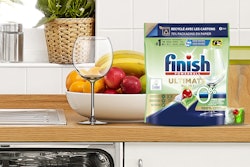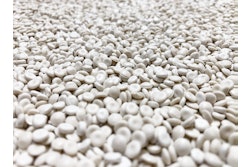A pilot program for residential recycling of hard-to-recycle plastic films is being piloted by Dow, WM (formerly Waste Management), and leading edge film converter Natura PCR (formerly Avangard Innovative, acquired by WM). The two publicly traded companies, plus WM’s Natura PCR, are rolling out a program allowing consumers in select markets to recycle them directly in their curbside recycling, announced at the end of 2022.
According to the Recycling Partnership, only 1.9% of U.S. households currently have access to curbside plastic film recycling, which is the plastic material with the lowest overall recycling rate. At this point, mono-material polyethylene films are the recovery goal; the technology for recycling of multilayer flexible packaging isn’t there yet, though the panel says that chemical recycling has a lot of promise in this arena.
Three of the key cogs in this circular mechanism were at the Packaging Recycling Conference today to explain more and respond to questions.
WM has a controlling interest in Natura PCR, a company that’s expected to scale recycling capacity to produce an estimated 400 million pounds of PCR pellets, per year, in five years. It’s also expected to provide circular solutions for films and clear plastic wrap used commercially, such as plastic stretch wrap for pallets, furniture film, grocery bags, and potential, shrink wrap around food and beverage containers.
“When we look at plastics for WM, especially on the recycling side, it's only about 5% of the material that we collect every day in our customers’ bins. But it represents about 40% of the value,” says Brent Bell, president of WM. “And it also represents nearly 100% of the conversations we have. Everywhere we go, we get asked about our supply of it. We're in a unique position because we're often seen as the gatekeeper for this material, and we’re asked to unlock more supply.”
“When we look at the statistics around recycling rates, film and flexible packaging specifically have a less than 2% recycling rate here in the U.S.” adds Dow’s Haley Lowry. “That means that the material is going to land fill or [litter]. I think that's a huge opportunity for us to figure out how do we unlock more of that material and build that back into the circular system.”
The initiative kicked off in suburban Chicago, with an initial pilot program in Hickory Hills, Ill., reaching approximately 3,500 households. More towns and cities are said to be following. Consumers in the program’s pilot cities will be able to recycle film plastics like bread bags, cling wrap, and dry-cleaning bags directly in their curbside recycling.
“All of this is being done with the intent to scale like we need filled with flexible collection, we need to make it easy for consumers. And we don't want that material going to landfill. We see it has value,” Lowry says.
Existing programs for film and flexible packaging recycling exists with the Sustainable Packaging Coalition's How2Recycle program, but adoption is currently low since to participate, “you’ve got to really want it,” Lowry says. It’s a high barrier to entry for consumers to clear to collect, then drop off bags upon their next trip to the store.
Sea change for WM MRFs is “heavy on the automation side”
For a MRF and hauler like WM, the introduction of films into material recovery ecosystems is fraught. Plastic films and flexible packaging are a hazard, as they constitute the number one problem-producer on current equipment. Films and flexible packaging materials get caught around the spinning elements equipment and generally gum up the works.
But WM already recycles films for retailers, who go through scads of shrink film every day in depalletizing. The company has a certain expertise in film recycling, it just doesn’t go through a traditional MRF.
“Most of the [near] billion-dollar investment is heavy on the automation side, right. And that helps us because labor is hard to find anyway, it’s hard to fill those positions,” WM’s Bell says. “We’re looking to improve the material quality that we achieve. Some of these technologies are patented, but some of it is just using a lot of optical sorters. But the main thing is there's not as many rotating screens for the films to rotate around. We use some traditional technology we're using for [our devoted film recovery facilities]. We're also working with some companies on new technology, different trying to they were really excited about that working in paper traction.”
WM expects to invest over $800 million through 2025 to improve and enhance recycling infrastructure, including specialized technology that will allow WM to sort plastic films. WM will lead the collection and processing for the film recycling pilots and continue to identify film recycling opportunities across the U.S. By 2025, film recycling through WM is expected to reach 8% of U.S. households.
Dow is supporting this initiative by incorporating recycled content into its product solutions, in line with the company’s recently updated Transform the Waste sustainability commitment to deliver 3 million metric tons of circular and renewable solutions by 2030.
“Frankly, it is about products that we sell, but it's not just about products that we sell. It's a different game. And what you see [on the stage] up here is about the ecosystem that's being created,” Lowry says. “If we don't have an ecosystem to drive circular products through the chain, that's not none of these, none of these ambitions that any of us that are going to be met. I think that's what you see represented here, which I'm really excited about.”
Once operating at full capacity, this program is expected to help divert more than 120,000 metric tons (MT) of plastics film from landfills annually. PW




























